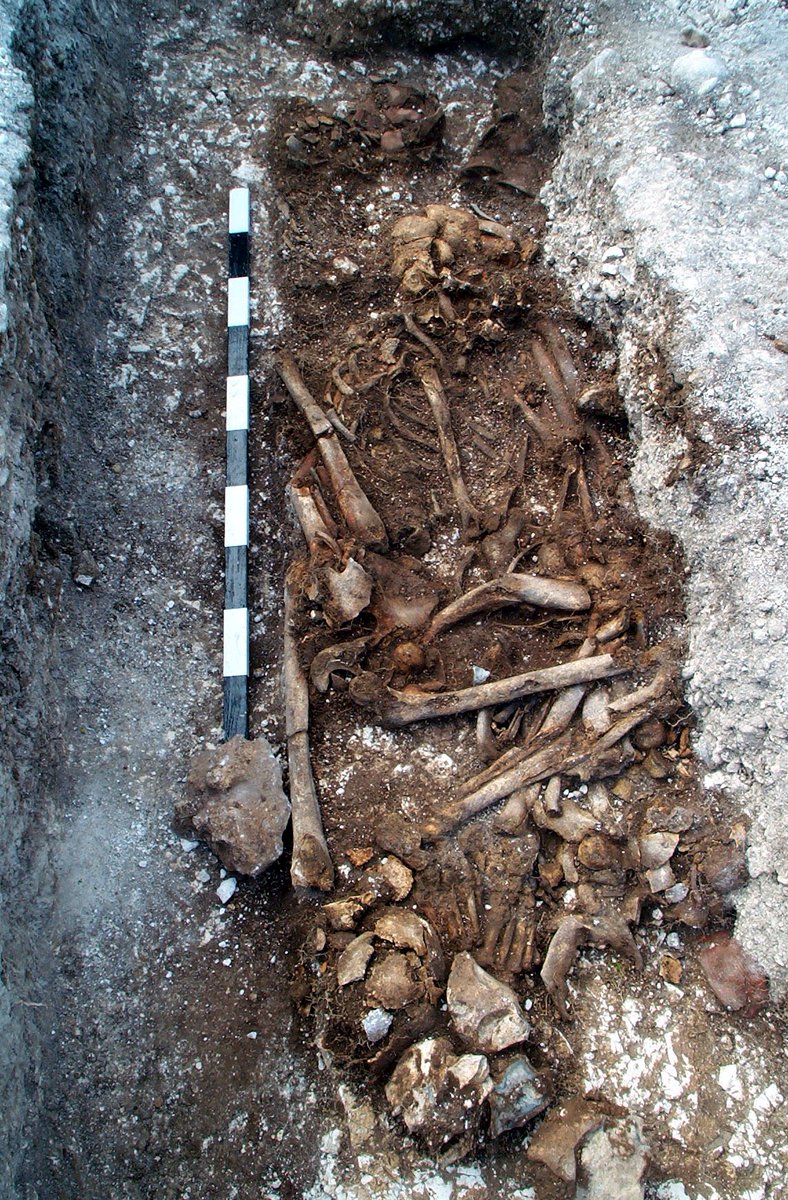
Here’s a look at some more of our finds recently featured in the ‘The world of Stonehenge’ exhibition publication, this time from the unusual ‘Boscombe Bowmen’ grave which we excavated 600 metres north of the ‘Amesbury Archer’s’ grave at Amesbury Down, near Stonehenge. 

The communal grave contained the remains of nine, possibly ten, individuals including one infant (cremated), two children, one teenager and five adult males.
#wessexarchaeology #wessexarch #stonehenge #stonehengelandscape #flint #flintarrowheads #prehistory #lateneolithic
#wessexarchaeology #wessexarch #stonehenge #stonehengelandscape #flint #flintarrowheads #prehistory #lateneolithic
Much of the bone had been curated and redeposited, placed in bundles within the grave lying around (generally just below) and – in the case of a few random bones – above the in situ (articulated) remains of one of the adult males.
#wessexarchaeology #wessexarch #stonehenge
#wessexarchaeology #wessexarch #stonehenge
The oldest mortuary deposits within the grave, comprising some of the redeposited bone, has been radiocarbon dated (C14) to between 2580 and 2340 BC.
#wessexarchaeology #wessexarch #stonehenge #stonehengelandscape #flint #flintarrowheads #prehistory
#wessexarchaeology #wessexarch #stonehenge #stonehengelandscape #flint #flintarrowheads #prehistory

The in situ, articulated burial remains (i.e. undisturbed) at the base of the grave (one of the children and an adult male) were dated to between 2470-2200 BC, but two of the other burials (one from the base & one from the upper fill of the grave) were shown to have been made...
...much later (2190–1950 BC). This places the grave within the earliest period of the Beaker phenomenon, a time when communal graves were relatively rare (but not unknown) and graves containing the remains of single individuals were the norm in Britain.
Stratigraphic evidence – demonstrating how the grave was constructed, used and then fell-out of use – showed that the grave had an integral wooden chamber, which would have included a lid allowing access to facilitate additions and modification of the materials inside it.
The date of the human remains and the location of the grave suggests that at least some of the individuals buried here might well have contributed to the building of Stonehenge.
#wessexarchaeology #wessexarch #stonehenge #stonehengelandscape #flint
#wessexarchaeology #wessexarch #stonehenge #stonehengelandscape #flint

Here, you can see an example of one of the eight Beaker pots as well as flint arrowheads, an antler pendant & boar tusks forming part of the grave goods. The Beaker vessel pictured here measures about 10.6 cm in height whilst the flint arrowheads measure a delicate 2cm in length.
The number of individuals from this grave is amongst the greatest number recovered from a single Beaker grave in Britain, matched by having the greatest number of Beaker pots from one grave.
#wessexarchaeology #wessexarch #stonehenge #stonehengelandscape #flint #flintarrowheads
#wessexarchaeology #wessexarch #stonehenge #stonehengelandscape #flint #flintarrowheads
Seven of the eight pots were decorated, six with cord and one with plaited cord. Use of such plaited cord was extremely rare for Beaker vessels in Britain although this style was commonly seen in continental Europe.
#wessexarchaeology #wessexarch #stonehenge #stonehengelandscape
#wessexarchaeology #wessexarch #stonehenge #stonehengelandscape
Check out the link below to read the full story on our contribution to the latest Stonehenge exhibition - wessexarch.co.uk/news/stoneheng…
#wessexarchaeology #wessexarch #stonehenge #stonehengelandscape #flint #flintarrowheads #prehistory #lateneolithic #neolithic #earlyprehistory
#wessexarchaeology #wessexarch #stonehenge #stonehengelandscape #flint #flintarrowheads #prehistory #lateneolithic #neolithic #earlyprehistory
• • •
Missing some Tweet in this thread? You can try to
force a refresh


















